25% Of SVOD Subs And One-Third Of New Sign-Ups Are Now Ad-Supported
- by Karlene Lukovitz @KLmarketdaily, June 30, 2023
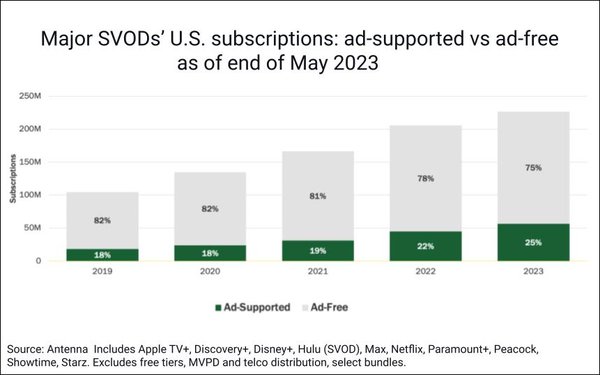
As of the end of May 2023, a quarter of the major streaming services’ total U.S. paid subscriptions, or SVODs, are ad-supported, according to a new report from Antenna (chart above).
In addition, nearly a third (32%) of all new sign-ups to SVODs are ad-supported.
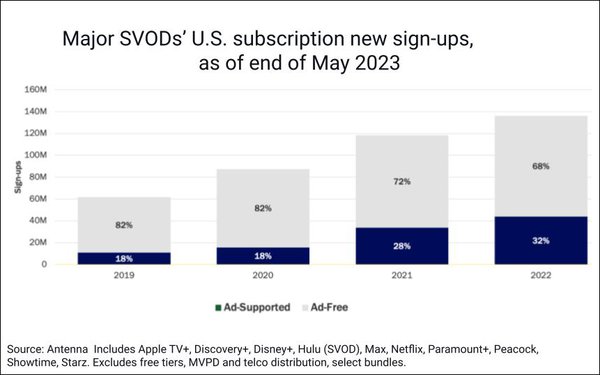
However, the saturation of ad-supported popularity varies significantly across services.
Here’s a look at seven of the 10 services analyzed by Antenna. (Apple+, Showtime and Starz are also included in most of the other charts and stats presented.)
Two-in-three sign-ups for Peacock in Q1 2023 were for the ad-supported plan, and more than one in three sign-ups to Disney+ were for its ad-supported tier, launched in December. In comparison, fewer than one in five sign-ups to HBO Max (now Max) and Netflix were for their ad-supported tiers.
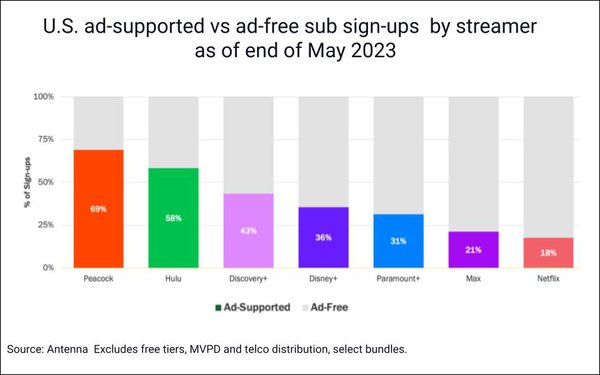
To analyze how streaming service subscribers react to advertising, Antenna created four segments: “Ad Avoiders,” “Ad Takers,” “Ad Managers,” and “Ad-Oblivious.” When given a choice between ad-supported and ad-free service, Ad Avoiders always choose ad-free plans, Ad Takers always choose the lowest-cost ad-supported plan, and Ad Managers mix and match ad-supported and ad-free plans. The Ad-Oblivious have not yet signed up for a service where they have had to make a choice about advertising.
Only three years ago, 64% of U.S. video streaming subscribers were ad-oblivious. But that number is now down to 32%, reflecting that about a third of American subscribers have been presented with an ad choice for the first time within the past three years.
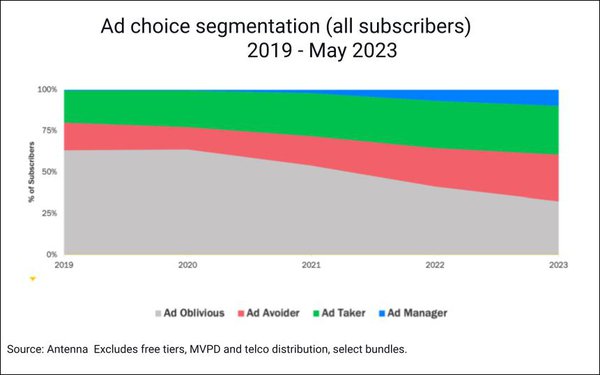
“Essentially, there was no way for the industry to know whether their consumers understood or bought into the value proposition of advertising, and little ability to predict how they would react to this grand experiment that was made across many consumers in a very short period of time,” sums up Antenna. “And about one in three subscribers remain Ad-Oblivious,” so the next couple of years will be key in determining advertising’s role in subscription video.
To date, when the Ad-Oblivious are excluded, Ad Avoiders are the largest segment, at 42%.
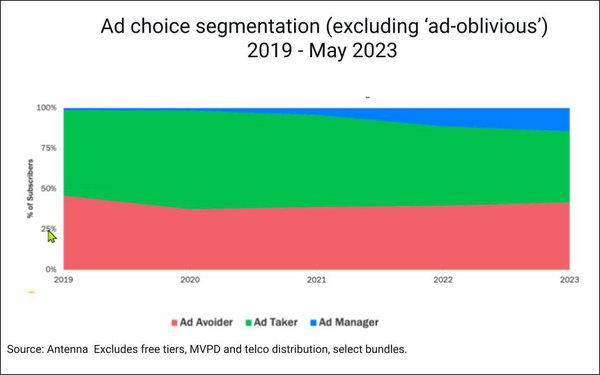
But 58% of U.S. streaming consumers overall have chosen advertising either some or all of the time when given the choice. And the Ad Manager segment, while still small, is growing rapidly. In fact, it’s emerging as the dominant consumer behavior pattern, according to Antenna.
Consumers can’t be considered Ad Managers until they’ve made at least two ads-versus-no ads decisions. Among those who have made multiple decisions, 71% have chosen advertising at least once, and nearly one in two have made mixed decisions, qualifying them as Ad Managers.
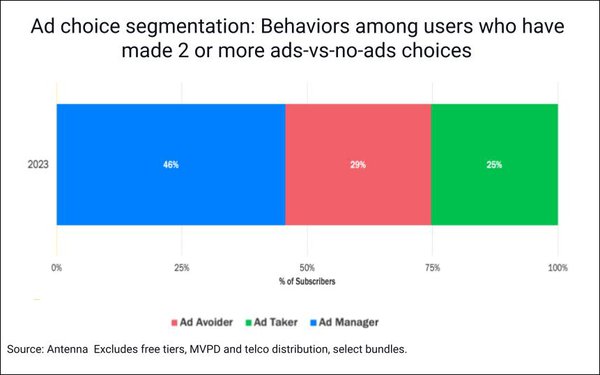
“Consumers are not only learning to choose whether or not they want ads; they are also learning to make the decision on a service-by-service basis,” sums up Antenna, and “the ramifications of this conduct for the media industry are substantial.” Streaming service operators will need to understand what drives these ad choices, particularly among Ad Managers. And building an advertising media plan that includes streaming services — already complicated — will be even more challenging.
What drives these choices? Not demographics. The data show no skews by age, gender, ethnicity or even household income when it comes to the four choice profiles.

As Antenna points out, this is positive news for the advertisers, “many of whom feared they would lose access to broad swaths of their brands’ target markets if entire demographic groups opted out of ads,” and also positive news for society as a whole, since there has been speculation that the introduction of ad-supported tiers could effectively end up turning advertising into a “tax” on less affluent people.
It turns out that the biggest drive of ads-versus-no ads choices comes down to the specific service in question.
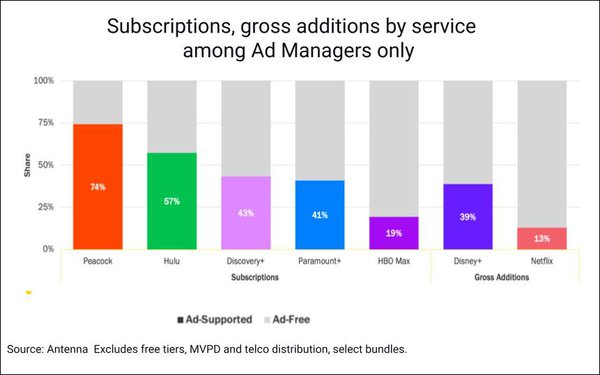
For example, three in four Ad Managers who have subscribed to Peacock have chosen the ad-supported plan, and more than half of Ad Managers who have subscribed to Hulu have chosen the ad-supported plan.
In contrast, just 19% of Ad Managers who have subscribed to HBO Max picked the ad-supported plan, and only 13% of Ad Managers who have signed up for Netflix since it launched its “Standard with Ads” plan in November 2022 have chosen that option.
This doesn’t answer why the ad-supported option is so much more dominant for some streaming services than others.
“Many factors could be at play,” notes Antenna. “Is it the type of content each service features? How well their ads are integrated into the experience? Ad loads? The difference in price between their ad-free and ad-supported options? Whatever the case, the advertising industry will spend the coming years understanding these drivers and tweaking their plan strategies accordingly.”
But the overall takeaway is a “strikingly optimistic story for the advertising industry,” the analysts add. “Consumers clearly understand the value that advertising contributes to funding the production of the storytelling that they love. The Antenna data is clear: given the choice, most Americans choose advertising.”


